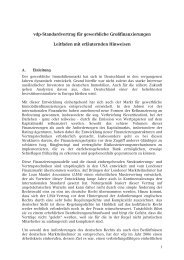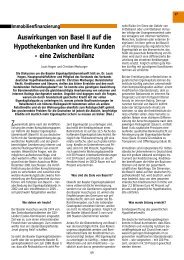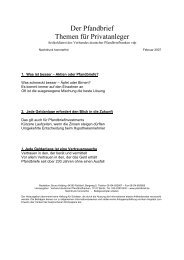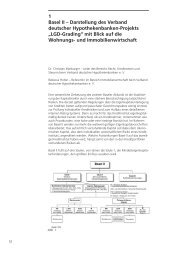The Pfandbrief 2011 | 2012
The Pfandbrief 2011 | 2012
The Pfandbrief 2011 | 2012
You also want an ePaper? Increase the reach of your titles
YUMPU automatically turns print PDFs into web optimized ePapers that Google loves.
Preface<br />
Dear Reader,<br />
4<br />
For over a year now, the eurozone debt crisis has dominated the sentiment on the global<br />
capital market. <strong>The</strong> <strong>Pfandbrief</strong> has held up well in this difficult environment, just as it<br />
had previously done during the bank crisis. Its importance as a safe haven for investment<br />
capital remains undisputed. Investors appreciate the safety of the <strong>Pfandbrief</strong>, its<br />
liquidity and transparency – especially in difficult times. Policymakers and regulators,<br />
too, are aware of the stabilizing effect of the <strong>Pfandbrief</strong> on the financial system as a<br />
whole, and take this into account in the forthcoming regulatory environment. <strong>The</strong> number<br />
of issuers is rising, and the concept of high-quality covered bank bonds continues to<br />
spread both in the eurozone and further afield. Relevant parliamentary bills in the USA,<br />
Canada, Australia and New Zealand are evidence that banks are increasingly resorting to<br />
secured refinancing.<br />
All things considered, therefore, the <strong>Pfandbrief</strong> showed itself in a very positive light<br />
as at mid-<strong>2011</strong>. Yet there is no reason for complacency: the challenges which the banking<br />
industry will have to overcome in the years ahead are too demanding and multifaceted<br />
for that. Refinancing in particular is becoming the central strategic challenge<br />
facing the banking sector given the proposals for new capital rules for banks and insurers,<br />
known as Basel III and Solvency II. This is true primarily of unsecured funding. For<br />
example, under the Basel III liquidity rules, senior unsecured debt issued by banks is<br />
to be treated less favorable than corporate bonds. Nor will the <strong>Pfandbrief</strong> remain unaffected.<br />
Although the regulatory initiatives recognize the high quality of the <strong>Pfandbrief</strong> in<br />
principle, the proposed new capital rules for banks fail to give appropriate consideration<br />
to low-risk cover pool eligible lending activities.<br />
One thing is certain: Basel III and Solvency II will change the German banking landscape.<br />
It remains to be seen whether the changes that are initiated will move in the<br />
direction policymakers and regulators would like to see. One reason for this is, without<br />
doubt, that the analysis of the cumulative effect of all the planned regulatory initiatives<br />
has so far been wholly insufficient. An efficient regulation which seeks to enhance the<br />
stability of the financial system should not be allowed to put products such as <strong>Pfandbrief</strong>e,<br />
which can contribute towards such stabilization, at a disadvantage. Instead, it<br />
should offer incentives to use them.<br />
<strong>Pfandbrief</strong> Banks ought to be able to continue to rely on their highly efficient and<br />
especially favorable refinancing instrument. It is therefore crucial that regulators and<br />
policymakers make the necessary adjustments when shaping the European supervisory
















